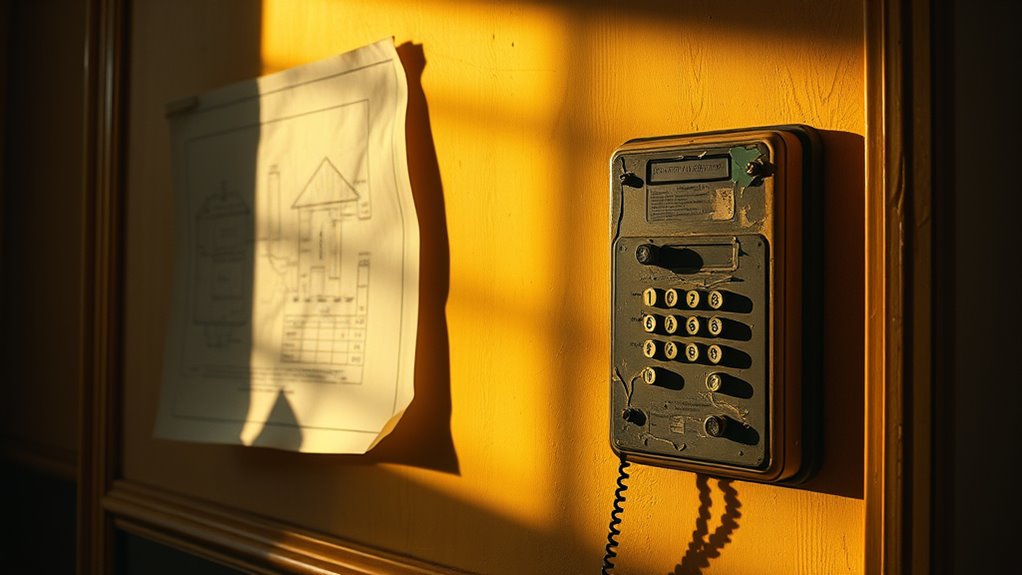Home intercom systems became popular in the mid-20th century, offering convenient, wired communication within households with charming designs and basic features. As technology advanced, wireless and digital systems replaced them, providing easier installation and smarter connectivity. Over time, aging infrastructure and limited features led to their decline, but their nostalgic appeal remains. To explore how these systems shaped family life and what’s next, keep exploring this fascinating history.
Key Takeaways
- Home intercoms gained popularity in the mid-20th century for family communication and decorative home features.
- Their reliance on bulky wiring and limited features led to high costs and installation challenges.
- Technological advancements shifted preferences toward wireless and digital systems, reducing reliance on traditional wired intercoms.
- The rise of smart home technology and seamless connectivity caused traditional intercoms to become obsolete.
- Nostalgic vintage designs remain valued for their charm but are mostly preserved as decorative or collector’s items today.
The Early Days and Technological Beginnings
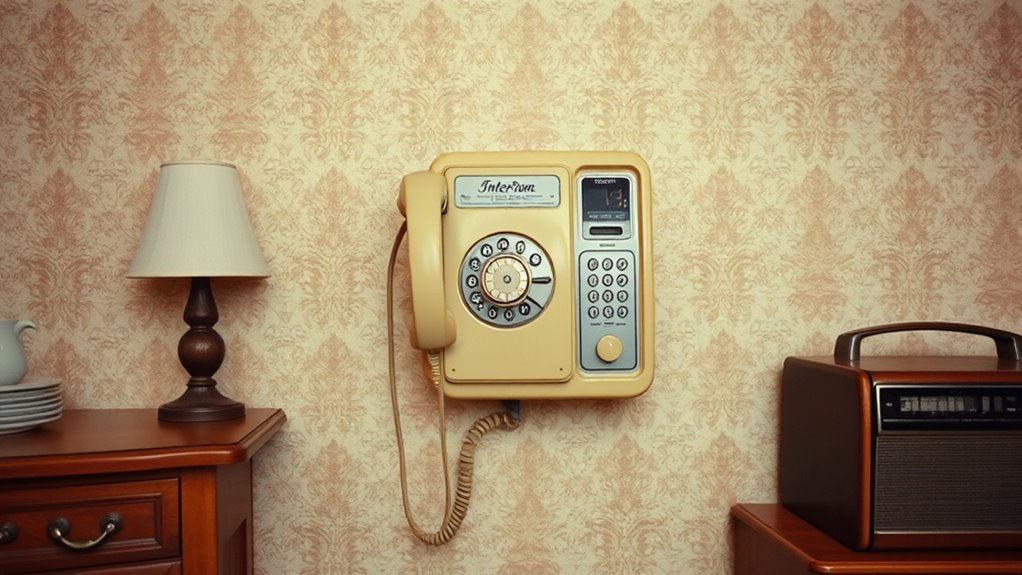
In the early days, home intercom systems were groundbreaking, offering a new level of convenience for families. During this era, designers prioritized vintage aesthetics, giving devices a charming, nostalgic look that appealed to homeowners. However, manufacturing challenges limited widespread adoption. Early models often faced issues with durability, sound clarity, and reliability, making them expensive and difficult to produce consistently. These systems relied on bulky components and intricate wiring, which increased costs and complexities. Despite these hurdles, inventors and engineers pushed forward, driven by the promise of seamless communication within the home. The vintage appeal of these early intercoms remains a testament to their innovative spirit, even as technological limitations slowed their evolution in the initial years.
Features and Popularity in the Mid-20th Century
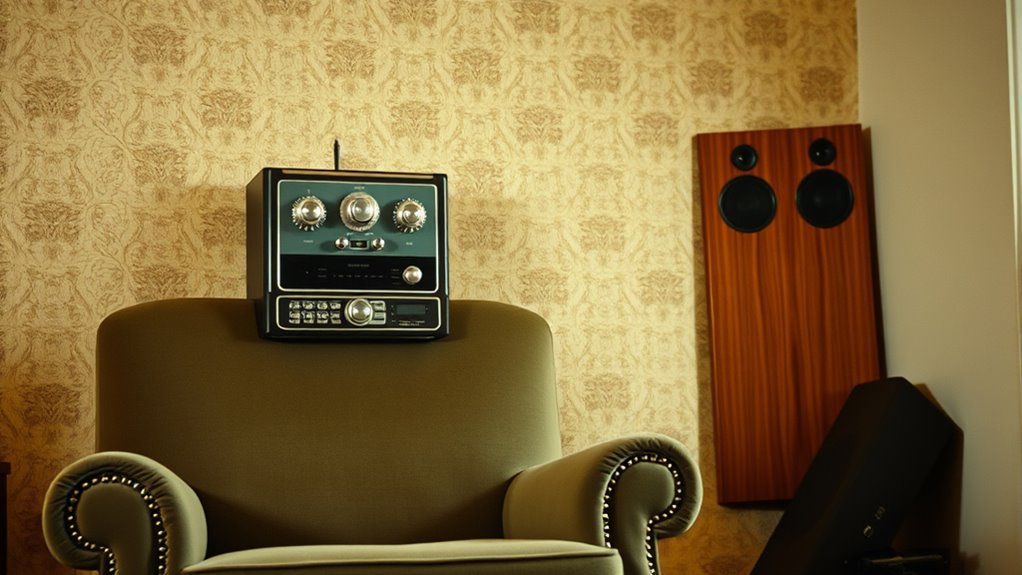
As home intercom systems gained popularity during the mid-20th century, manufacturers introduced a range of features that made them more practical and appealing to families. They focused on intercom aesthetics and decorative design, ensuring units blended seamlessly with home decor. These systems often included multiple stations, allowing communication across rooms or floors, and added convenience with volume controls and push-button operation. The visual appeal was enhanced by sleek, stylish casings, often matching popular interior styles. Here’s a glimpse of typical features:
| Feature | Description | Design Focus |
|---|---|---|
| Multiple Stations | Communicate across various rooms | Decorative design |
| Volume Control | Adjust sound levels easily | Intercom aesthetics |
| Visual Indicators | Lights or dials for status | Stylish, integrated |
The Design and Functionality of Classic Intercoms
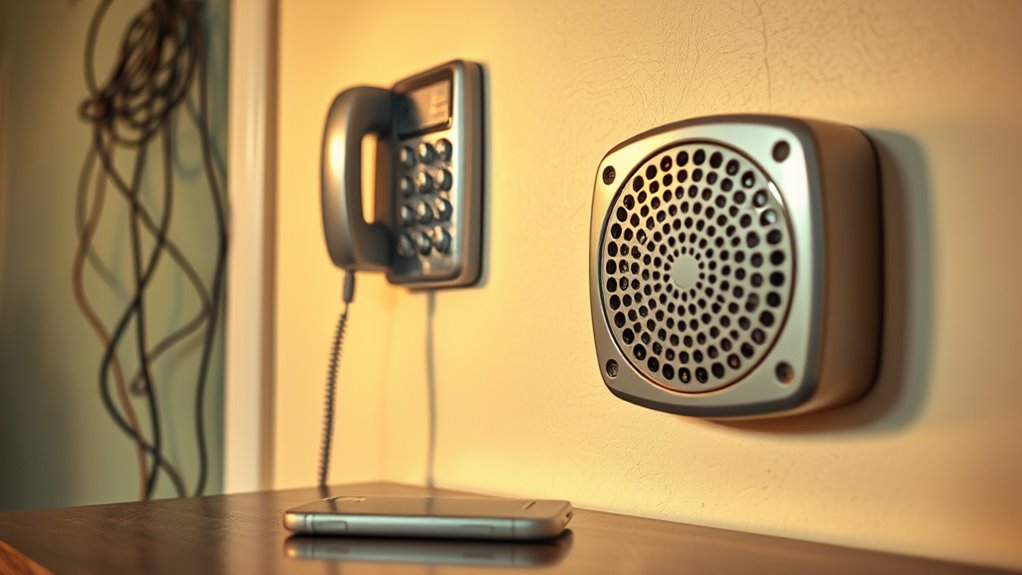
Classic intercoms primarily provide basic audio communication within a home, allowing you to talk from one room to another. They typically use wired system architecture, which guarantees reliable connections but limits mobility. Privacy and security were built-in features, helping you control who could listen in or respond. Additionally, some models integrated intercom security features to prevent unauthorized access.
Basic Audio Communication
A basic home intercom system uses simple audio communication to connect different rooms within a house. It operates through a speaker and microphone setup, transmitting sound signals via wired or wireless links. When you need to perform intercom installation, verify the wiring is secure and connections are correct. Troubleshooting common issues involves checking power sources, adjusting volume, or inspecting wiring for faults. Here’s a quick overview:
| Step | Action | Result |
|---|---|---|
| Check power | Ensure the intercom is plugged in | System powers on properly |
| Inspect wiring | Look for loose connections | Clear audio signals |
| Test microphones | Speak and listen for clarity | Confirm proper functioning |
| Adjust volume | Increase or decrease as needed | Clearer communication |
| Troubleshoot | Identify and fix faults | Restored intercom operation |
This straightforward setup makes communication easy and reliable. Additionally, ensuring the system’s power sources are adequate helps maintain consistent performance.
Wired System Architecture
Wired home intercom systems rely on dedicated physical connections to transmit audio signals between units, ensuring reliable and clear communication. This architecture means each device connects via wires, often running through walls or ceilings, which can make installation challenging. You need to plan carefully to avoid future intercom maintenance issues, such as troubleshooting faulty wiring or replacing damaged cables. The design offers consistent audio quality because signals don’t depend on wireless signals that can be disrupted. However, this setup limits flexibility; adding or relocating units involves complex wiring work. Despite these challenges, wired systems provide dependable performance and are less susceptible to interference. Overall, their architecture emphasizes durability and sound clarity, making them a popular choice before wireless technology became dominant. Additionally, installation complexity can be a significant factor to consider when choosing this type of system.
Privacy and Security
Because wired intercom systems rely on dedicated physical connections, they inherently offer a level of privacy and security that wireless systems often struggle to provide. With encrypted channels, your conversations stay private, making eavesdropping much more difficult. Classic intercoms also rely on user authentication to ensure only authorized users can access or operate the system. This combination of secure encryption and strict authentication minimizes the risk of unauthorized access or interception. Unlike wireless systems that can be vulnerable to hacking or signal jamming, wired intercoms maintain their integrity through physical connections. This design prioritizes your privacy, providing reliable communication within your home without exposing you to the common vulnerabilities associated with wireless technology. Additionally, the tangible nature of wired intercoms reduces the risk of digital breaches, as they do not rely on network connections that can be compromised.
Key Benefits That Made Intercoms a Household Staple
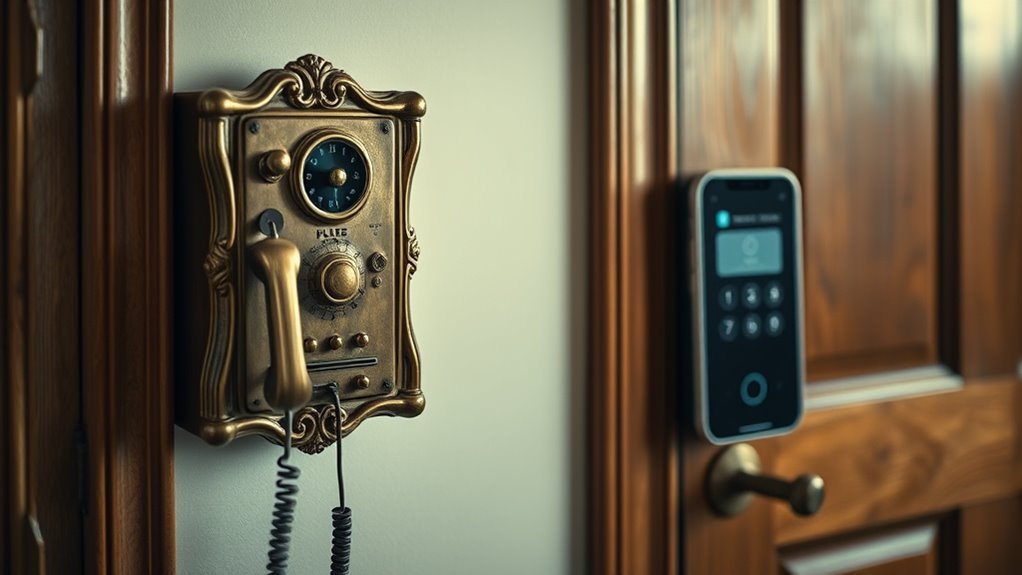
Intercoms became a household staple because they offered instant, reliable communication across different parts of a home. You could effortlessly connect with family members, whether in the kitchen or basement, without shouting or running around. Their vintage design added charm and nostalgia, making them more than just functional devices—they became part of your home’s character. The ease of intercom installation meant anyone could set them up easily, enhancing safety and convenience. Imagine calling your kids for dinner or checking if the front door is secure—all from one central point. These benefits fostered a sense of connectedness and security that many homes cherished. Additionally, the user-friendly interfaces of vintage models contributed to their widespread popularity and ease of use.
The Rise of Wireless and Digital Communication Technologies

As technology advances, wireless and digital communication tools have transformed how you stay connected at home. These innovations offer sleek intercom aesthetics that blend seamlessly with modern decor, enhancing your living space. You no longer face installation challenges like wiring or bulky hardware, making setup quick and hassle-free. Instead, you enjoy instant communication with just a tap or voice command. The rise of Wi-Fi and Bluetooth connectivity has made intercoms more versatile, allowing for integration with smart home systems. These advancements evoke feelings of convenience and efficiency, transforming your daily routines. With wireless and digital tech, communication becomes effortless, reliable, and visually appealing—ushering in a new era of home connectivity that feels both futuristic and user-friendly. Additionally, incorporating space and organization strategies can help you create a more streamlined environment that complements your modern communication devices.
The Decline: Factors Leading to Obsolescence

Despite their early popularity, traditional home intercom systems have gradually fallen out of favor due to several key factors. One major issue was intercom troubleshooting; as systems aged, fixing technical problems became complicated and costly, discouraging maintenance. Additionally, installation challenges played a significant role. Many older systems required complex wiring and professional setup, making upgrades or repairs difficult. As wireless and digital technologies advanced, these systems became outdated, offering limited features compared to modern alternatives. The lack of compatibility with smart home devices also contributed to their decline. Overall, the combination of troubleshooting difficulties and installation obstacles made traditional intercoms less practical, accelerating their obsolescence and paving the way for newer, more integrated communication methods. Incorporating automation tools could have streamlined maintenance and updates, potentially extending their relevance.
Nostalgic Value and Modern Replacements

While traditional home intercom systems have largely faded from everyday use, many people still cherish their nostalgic charm. The vintage design of these devices brings back memories of simpler times, making them sentimental keepsakes. You might consider intercom installation to preserve that retro vibe or incorporate vintage-inspired models into your home. Here are four reasons why the nostalgia persists:
Vintage intercoms evoke nostalgic charm and timeless memories in modern homes.
- Sentimental Value — reminds you of childhood or family moments.
- Unique Aesthetic — adds character with vintage design elements.
- Conversation Starters — sparks curiosity among guests.
- Modern Replacements — offer sleek, wireless options that retain retro appeal.
- The technology behind these systems also highlights the evolution from wired to wireless communication, bridging the gap between nostalgia and modern convenience.
These modern replacements blend convenience with nostalgia, allowing you to enjoy the best of both worlds.
The Cultural Impact and Legacy of Home Intercoms

Home intercom systems didn’t just serve practical purposes; they became symbols of community and family life in the mid-20th century. They fostered a sense of connection within households, making communication effortless and immediate. This created a strong cultural nostalgia, reminding many of simpler times when families relied on these devices for daily interaction. The legacy influence of home intercoms extends beyond their functional use, shaping how we think about domestic communication. They influenced later technology, paving the way for modern interconnectivity within homes. Their presence in popular media and personal stories cemented their place in cultural memory. Today, while replaced by smartphones and smart home systems, the nostalgic value persists, reminding us of a time when communication was more personal and communal. Understanding the technological evolution of communication devices highlights how far we’ve come from these early intercom systems.
Future Trends in Domestic Communication Systems
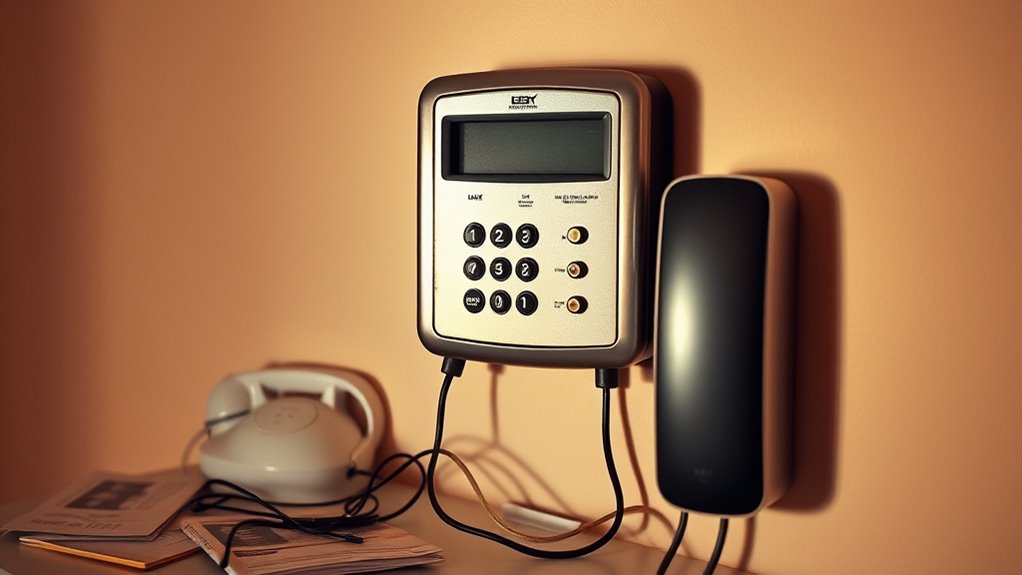
Future domestic communication systems will become smarter and more connected, making your home more intuitive. Wireless connectivity will improve, allowing seamless communication across devices. Voice command technology will transform how you interact with your home, offering hands-free control and instant responses. Additionally, integration with home security systems will enable real-time alerts and enhanced safety features.
Smart Home Integration
As technology continues to evolve, smart home integration is transforming domestic communication systems into seamless, interconnected networks. You’ll find yourself effortlessly controlling devices and communicating through centralized platforms. However, mastering intercom etiquette becomes essential to avoid misunderstandings, especially as systems grow more complex. You might face installation challenges, requiring patience and careful planning to guarantee everything connects smoothly. Imagine the emotional impact of a home where communication is instant and intuitive, yet you must navigate new protocols. Here are some key aspects to contemplate:
- Feeling empowered to manage your entire home effortlessly
- Overcoming installation hurdles with expert help
- Maintaining respectful communication amidst advanced tech
- Experiencing a future where your home responds intuitively to your needs
Wireless Connectivity Advances
Have you noticed how wireless connectivity is rapidly transforming domestic communication systems? Today, intercom installation is simpler and more flexible thanks to advancements in wireless tech. You no longer need complex wiring; instead, wireless intercoms connect seamlessly via Wi-Fi or Bluetooth, making setup faster and less intrusive. These systems deliver improved sound quality, ensuring clear, crisp communication across your home. As wireless standards evolve, stability and range increase, allowing you to communicate effortlessly between rooms or even remotely. This progress means you can expand your intercom network easily, adapting it to your changing needs. The focus on reliable, high-quality sound ensures that your conversations remain natural and effortless, demonstrating how wireless connectivity continues to enhance home communication systems.
Voice Command Technology
Advancements in wireless connectivity are paving the way for more intuitive and hands-free communication within your home. Voice command technology, powered by voice assistants and smart speakers, transforms how you interact with your environment. Imagine effortlessly controlling lights, locks, and appliances just by speaking. This seamless integration makes daily routines smoother and more personalized.
Here are four reasons you’ll love this future:
- Instant answers to your questions, anytime you need them.
- Hands-free control of your entire home, freeing you from manual adjustments.
- Personalized experiences tailored to your habits and preferences.
- Enhanced security with voice-activated alerts and monitoring.
This technology creates a smarter, more responsive home that adapts to you.
Frequently Asked Questions
What Were the Main Technological Innovations That Propelled Intercom Adoption?
You see, the main innovations that pushed intercom adoption include wireless connectivity, allowing seamless communication without wires, and sound amplification, which improves audio clarity. These advancements made intercom systems more convenient and reliable for homes. As you use these features, you notice how they enhance everyday communication, making it easier to connect with family members quickly and efficiently, driving the widespread popularity of intercom systems before their decline.
How Did Intercoms Influence Household Communication Dynamics Historically?
You see, intercoms transformed household communication by making it easier to connect quickly, but they also impacted family privacy. You might find that they enhanced social interactions within the home, allowing family members to communicate without shouting or leaving rooms. However, this convenience sometimes came at the expense of privacy, as everyone could hear conversations, influencing how family members shared personal thoughts and feelings openly.
Were There Regional Differences in the Popularity of Home Intercom Systems?
You might notice that regional preferences and cultural influences shaped how popular home intercom systems were across different areas. In some regions, such as North America, they gained quick popularity due to technological enthusiasm, while in others, cultural values around privacy limited their use. These differences highlight how local customs and societal attitudes influenced the adoption and decline of home intercom systems worldwide.
What Are the Most Common Reasons Consumers Replaced Intercoms With Other Technologies?
You replace your intercoms mainly because wireless integration offers more convenience and flexibility. You might also be concerned about privacy, as older systems could be vulnerable or less secure. Modern technologies like smartphones and smart home devices provide better security and remote access, making traditional intercoms less appealing. These factors drive consumers to upgrade, seeking seamless communication and enhanced privacy in their homes.
How Do Modern Home Communication Systems Compare in Cost and Functionality?
Modern home communication systems cost more upfront but offer advanced features like wireless technology and voice activation, making them more versatile. You can easily connect multiple devices and control them hands-free, enhancing convenience. While initial expenses are higher, the long-term benefits include better integration, security, and ease of use. Overall, these systems provide a significant upgrade in both functionality and modern design compared to older intercoms.
Conclusion
Like a trusty old lighthouse guiding ships home, the home intercom once illuminated our daily lives with simple connection. Though technological storms have swept it aside for newer, faster signals, its warm glow lingers in our memories. As you look to the horizon of modern communication, remember that every innovation is just a new lighthouse, casting its beam to guide us forward — but never forgetting the steady glow that once kept us close.
